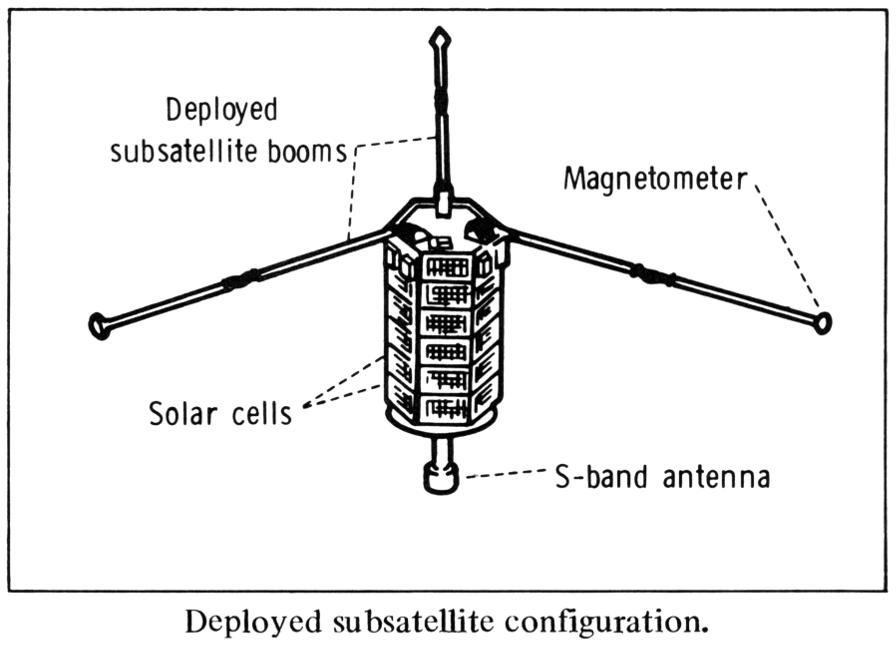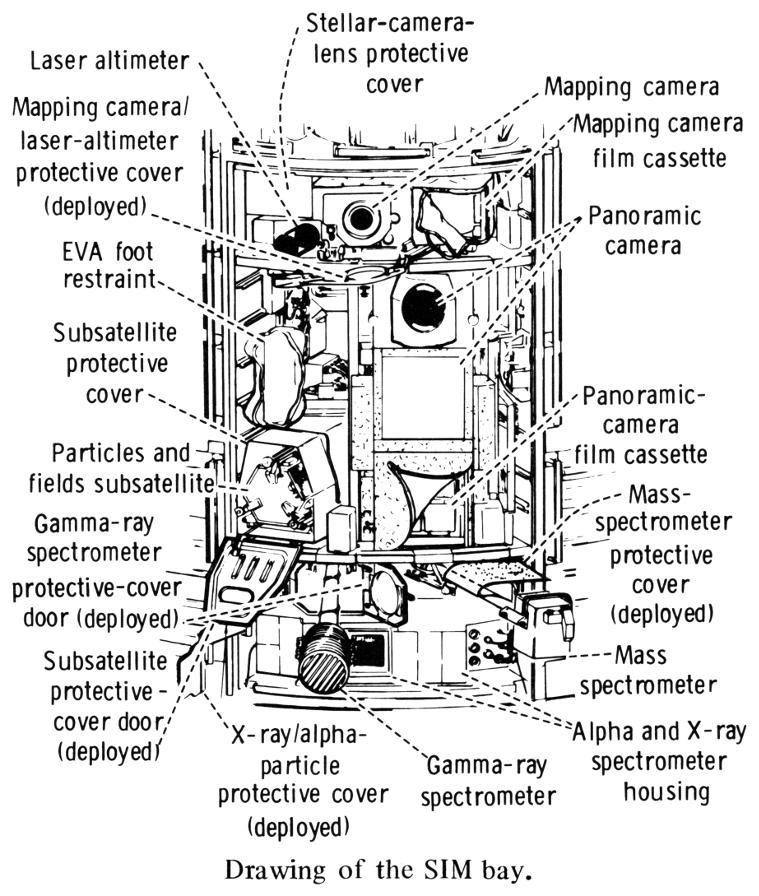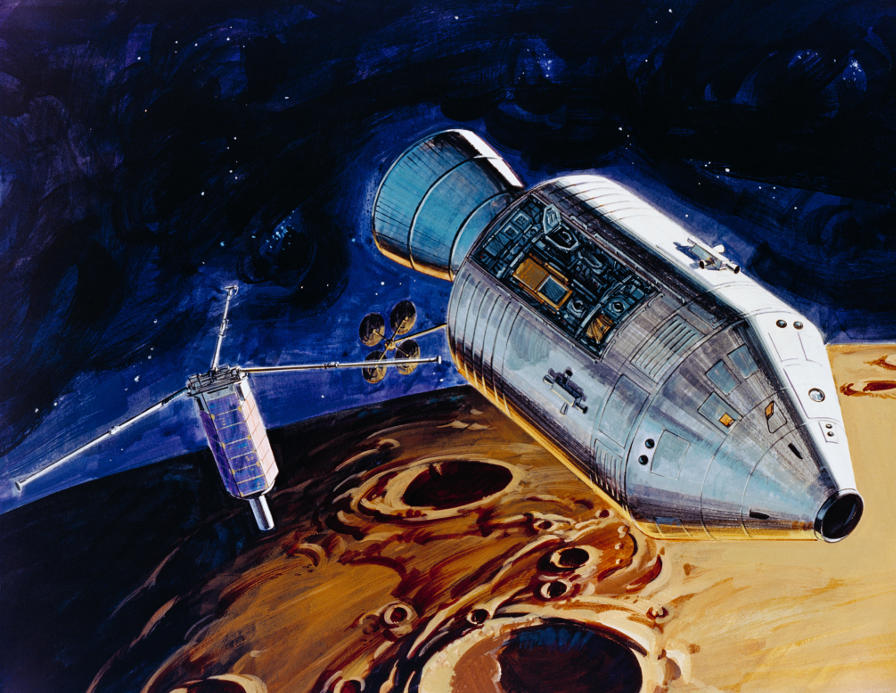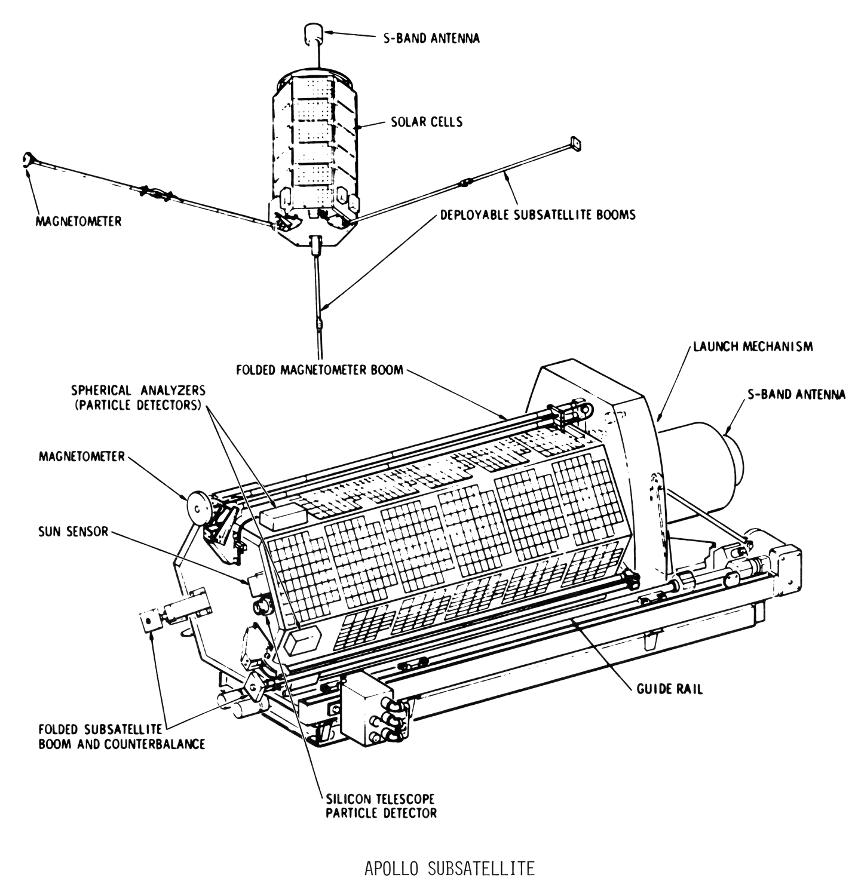Apollo Particles and Fields Subsatellite
The Apollo 15 and Apollo 16 missions, just prior to leaving lunar orbit, each deployed a small Apollo Particles and Fields Subsatellite. They were the first satellites deployed in this fashion.
Click image for a 2093x1373 pixel version of this image in a new window.
From page 62 of the On the Moon with Apollo 16 in the heroicrelics
library. Also available in electronic format
from the Apollo Lunar
Surface Journal.
Scan and cleanup by heroicrelics.org.
The satellite was stowed in the service module SIM (scientific instrument module) bay, housed in a container resembling a rural mailbox. The subsatellite was 31 inches long, had a 14-inch hexagonal diameter and weighed 78.5 pounds. It had three folded booms which each deployed to a length of five feet. A fluxgate magnetometer was on the end of one boom and the other two carried tip masses to provide balance. Electrical power was supplied by a solar cell array providing 25 watts, with a rechargeable silver-cadmium battery for nightside passes. The satellite was spring-ejected from the SIM bay with a velocity of 4 fps and was spin-stabilized with a spin rate of about 12 rpm once the booms were deployed.
The following two diagrams show the subsatellite stowed in the SIM bay.
The first diagram is of the Apollo 15 SIM bay, with all experiments in their stowed position. The Particles and Fields Subsatellite is located in near the lower left.
Click image for a 3782x5345 pixel version of this image in a new window.
From page 139 of the Apollo 15 Press Kit, located in the
"Apollo 14 Collection and Misc Material" collection, Dept. of Archives/Special
Collections, M. Louis Salmon Library, University of Alabama in
Huntsville. Also available in electronic format from the heroicrelics
mirror of the Kennedy Space Center Library press kit page.
Scan and cleanup by heroicrelics.org.
This second diagram is of the Apollo 16 SIM bay, depicting experiments in their active position. Mounted in the same location as on Apollo 15, here we see the Particles and Fields Subsatellite with its protective-cover door deployed:
Click image for a 1845x2178 pixel version of this image in a new window.
Adapted from page 2-6 of the Apollo 16 Preliminary Science Report.
Located in the Raynor Memorial
Libraries, Marquette University. Also available in electronic format
from the Apollo Lunar
Surface Journal.
Scan, cleanup, and adaptation by heroicrelics.org.
This NASA art shows the satellite shortly after deployment. While it shows a SIM bay, the subsatellite's protective-cover door deployed, and the CM's docking probe having been jettisoned, it also shows a Block I command module, with its vertical negative pitch thrusters and apparent two-piece hatch (although, since it seems to show two side windows under the rendezvous window, this latter detail might be excused).
NASA photo S71-39481: Deployment of the subsatellite in lunar orbit from the
SIM (scientific instrument module) bay.
Click image for additional information about this image in a new window.
The subsatellite deployment actually looked like this (at least on Apollo 15). This is a frame grab from motion picture footage shot by the crew; also see the series of photos starting with AS15-96-13067 (for whatever reason, subsequent photos in the series appear before the first photo, so it is necessary to click the left arrow to view the next photo).
Click image for a 1456x1080 pixel version of this image in a new window.
From the NASA video Apollo 15:
In the Mountains of the Moon on YouTube.
Frame grab and cleanup by heroicrelics.org.
Experiments carried aboard the subsatellite included an S-Band transponder for gathering data on the lunar gravitational field, especially gravitational anomalies such as the so-called mascons; Particle Shadows/Boundary Layer for gaining knowledge of the formation and dynamics of the Earth's magnetosphere, interaction of plasmas with the Moon and the physics of solar flares using telescope particle detectors and spherical electrostatic particle detectors; and Subsatellite Magnetometer for gathering physical and electrical property data on the Moon and of plasma interaction with the Moon using a biaxial flux-gate magnetometer deployed on one of the three five-foot folding booms.
The subsatellite was equipped with an S-band transponder to enable precision tracking of the spacecraft. The S-band transponder experiment used the precise doppler-tracking data of the satellite and the tracking data of the CSM and LM taken during the mission to provide detailed information about the gravitational field of the near side of the Moon. Minute changes in the spacecraft speed were recorded, as measured by an Earth-based radio tracking system which had a resolution of 0.65 mm/sec.
The subsatellite's plasma and particles experiment monitored the various plasma regimes in which the Moon moves, determining how the Moon interacts with the fields and plasmas within these regimes, and investigated the structure and dynamics of the Earth magnetosphere.
The subsatellite's magnetometer measured the permanent and induced components of the lunar magnetic field by systematically mapping the remanent magnetic field of the Moon and by measuring the magnetic effects of the interactions between cislunar plasmas and the lunar field. It measured variations in the magnetic field associated with several large craters as the subsatellite passed overhead. Data collected showed that the plasma void that forms behind the Moon when it is in the solar wind extends probably to the lunar surface, and the flow of the solar wind is itself rather strongly disturbed near the limbs of the Moon.
Click image for a 5811x6000 pixel version of this image in a new window.
A composite of page 65 of the Apollo 15 Press Kit, located in the
"Apollo 14 Collection and Misc Material" collection, Dept. of Archives/Special
Collections, M. Louis Salmon Library, University of Alabama in
Huntsville (also available in electronic format from the heroicrelics
mirror of the Kennedy Space Center Library press kit page) and page 62 of
On the Moon with Apollo 16 located in the heroicrelics library.
Also available in electronic format
from the Apollo Lunar
Surface Journal.
Scans, cleanup, and composite by heroicrelics.org.
Apollo 15's subsatellite was deployed on August 4, 1971. Two electronic failures in February 1972 caused the loss of most of its data channels, but the surviving channels transmitted data until January 1973, when ground support was terminated. The orbit of the subsatellite, no longer being tracked, is assumed to have decayed and the satellite crashed into the moon sometime after this, although the impact site is not known.
Apollo 16 suffered a malfunction with the SPS engine's backup thrust vector control; this delayed the lunar landing by about six hours. For the rest of the mission, mission controllers avoided firing the engine any more than absolutely necessary, which meant that a planned orbital adjustment was not performed prior to launching the subsatellite. The resulting lower orbit caused the subsatellite to impact the moon after a bit over a month (425 orbits around the moon).
The bulk of the descriptive text on this page was taken, largely verbatim, from the Apollo 15 Press Kit and the Apollo 15 Preliminary Science Report.






